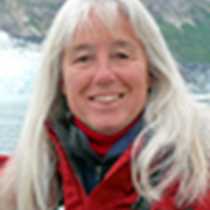Icy Strait and Idaho Inlet
Reports of green-glowing toilets are testimony to the richness of the Southeast Alaskan waters. Sea water in the toilet system aboard the Sea Bird contains tiny organisms that are capable of emitting a “cold light” called bioluminescence when they are disturbed (i.e., flushed, in this case). If we don’t tell people about this early in the voyage, they begin to worry that there may be something wrong with them.
Point Adolphus, in Icy Strait, epitomized this productivity this morning. It is a place where confused currents and irregular bathymetry conspire to bring nutrients to the surface, stimulating a complex food web. Amidst humpback whales, seabirds, porpoises, Steller sea lions and dozens of bald eagles that were enjoying the feast, keen eyes also spotted a brown bear on the shore of Chichagof Island. The ship approached as guests quietly emerged from their cabins and we watched the bear forage undisturbed. Soon this animal will be feeding on salmon returning to their natal streams and thus become part of an intimate connection between the ocean and forest biomes.
We enjoyed this lively area throughout the morning and then continued westward toward Inian Pass. A small group of islands lies between Icy Strait and Cross Sound, beyond which is the open Pacific Ocean. In the swirling waters between these islands we found more Steller sea lions, some of which were surfing in the wild waves, and also a few sea otters that were wrapped up in kelp. This keeps them from drifting away, in spite of the swells that roll in from the ocean.
Idaho Inlet juts into the north side of Chichagof Island. It is named for the steamship Idaho, which went aground near the head of the inlet. It was from here that we staged our afternoon activities, which included hiking, kayaking, and exploring via Zodiac. We examined the kelp that ringed Shaw Island and listened to humpback whales from across the inlet. We were awestruck by the age-old tracks worn through the moss by a habitual brown bear that repeatedly steps in the same place time after time. We marveled at the contrasting vegetation of the forest and bog. An interesting plant caught our eye – the northern groundcone (Boschniakia rossica, pictured here surrounded by dwarf dogwood, Cornus Canadensis). Lacking chlorophyll, it is unable to make its own food and must steal nourishment from the roots of nearby alder trees.
The plankton were evident again after dinner – attracting fish, which attracted whales. Maybe it’s not such a bad deal to be part of a ship’s “green flush” for a while, entertaining the guests and receiving a temporary reprieve from the inevitable and unrelenting food chain.
Reports of green-glowing toilets are testimony to the richness of the Southeast Alaskan waters. Sea water in the toilet system aboard the Sea Bird contains tiny organisms that are capable of emitting a “cold light” called bioluminescence when they are disturbed (i.e., flushed, in this case). If we don’t tell people about this early in the voyage, they begin to worry that there may be something wrong with them.
Point Adolphus, in Icy Strait, epitomized this productivity this morning. It is a place where confused currents and irregular bathymetry conspire to bring nutrients to the surface, stimulating a complex food web. Amidst humpback whales, seabirds, porpoises, Steller sea lions and dozens of bald eagles that were enjoying the feast, keen eyes also spotted a brown bear on the shore of Chichagof Island. The ship approached as guests quietly emerged from their cabins and we watched the bear forage undisturbed. Soon this animal will be feeding on salmon returning to their natal streams and thus become part of an intimate connection between the ocean and forest biomes.
We enjoyed this lively area throughout the morning and then continued westward toward Inian Pass. A small group of islands lies between Icy Strait and Cross Sound, beyond which is the open Pacific Ocean. In the swirling waters between these islands we found more Steller sea lions, some of which were surfing in the wild waves, and also a few sea otters that were wrapped up in kelp. This keeps them from drifting away, in spite of the swells that roll in from the ocean.
Idaho Inlet juts into the north side of Chichagof Island. It is named for the steamship Idaho, which went aground near the head of the inlet. It was from here that we staged our afternoon activities, which included hiking, kayaking, and exploring via Zodiac. We examined the kelp that ringed Shaw Island and listened to humpback whales from across the inlet. We were awestruck by the age-old tracks worn through the moss by a habitual brown bear that repeatedly steps in the same place time after time. We marveled at the contrasting vegetation of the forest and bog. An interesting plant caught our eye – the northern groundcone (Boschniakia rossica, pictured here surrounded by dwarf dogwood, Cornus Canadensis). Lacking chlorophyll, it is unable to make its own food and must steal nourishment from the roots of nearby alder trees.
The plankton were evident again after dinner – attracting fish, which attracted whales. Maybe it’s not such a bad deal to be part of a ship’s “green flush” for a while, entertaining the guests and receiving a temporary reprieve from the inevitable and unrelenting food chain.



